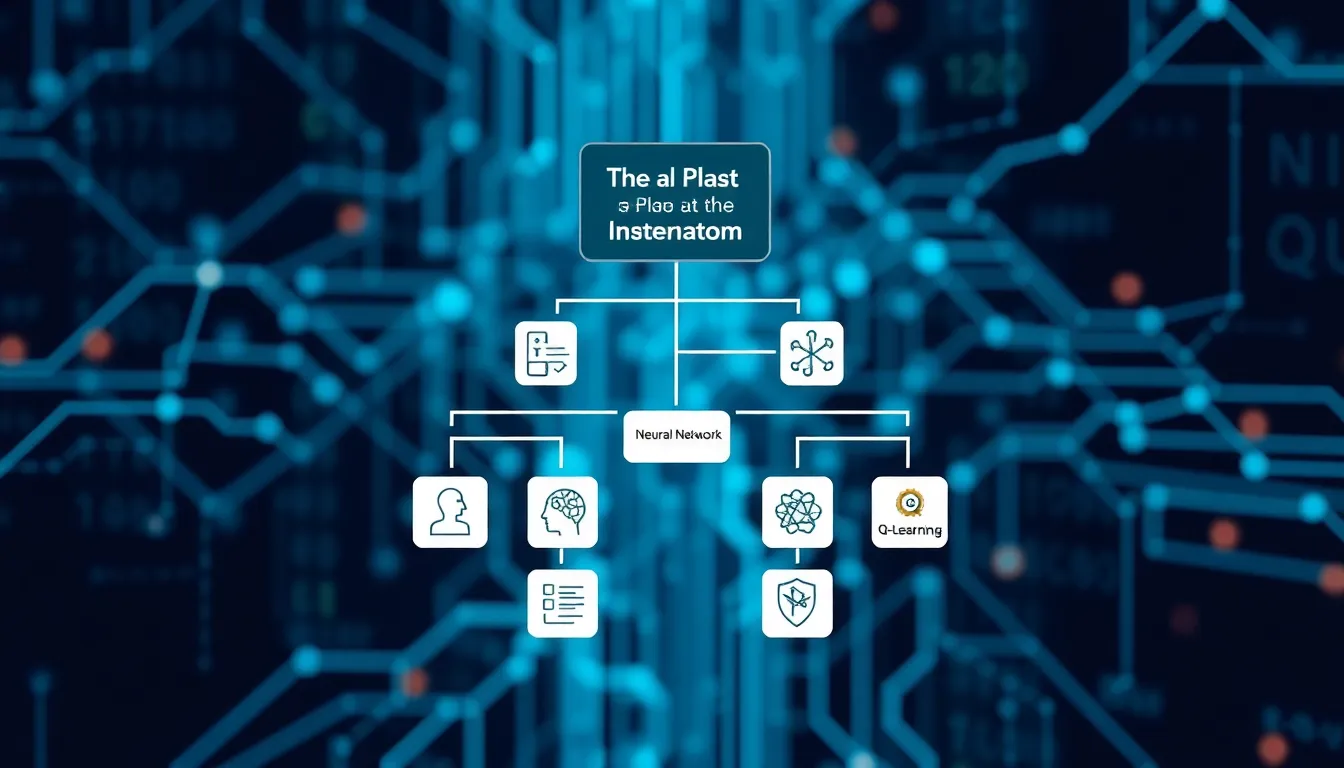Table of Contents
ToggleIn today’s data-driven world, machine learning algorithms are revolutionizing how businesses and industries operate. These powerful tools enable computers to learn from data, identify patterns, and make decisions with minimal human intervention. As technology continues to evolve, understanding these algorithms becomes essential for anyone looking to harness the full potential of artificial intelligence.
From predictive analytics to natural language processing, machine learning algorithms are at the heart of groundbreaking innovations. They empower everything from personalized recommendations on streaming platforms to advanced medical diagnostics. As organizations increasingly rely on data to drive their strategies, a solid grasp of these algorithms can unlock new opportunities and enhance decision-making processes.
Overview of Machine Learning Algorithms
Machine learning algorithms represent a crucial component of artificial intelligence, allowing systems to learn and adapt based on data. These algorithms can be categorized into three primary types: supervised learning, unsupervised learning, and reinforcement learning.
- Supervised Learning
Supervised learning relies on labeled datasets. The algorithm learns from training data comprising input-output pairs, enabling it to predict outcomes for unseen data. Common examples include linear regression for continuous outcomes and logistic regression for binary classification.
- Unsupervised Learning
Unsupervised learning uses unlabeled data, focusing on identifying patterns and structures within the dataset. Clustering algorithms, such as K-means and hierarchical clustering, group similar data points. Dimensionality reduction techniques, like principal component analysis (PCA), help simplify datasets while preserving essential information.
- Reinforcement Learning
Reinforcement learning emphasizes interaction with an environment, where an agent learns to make decisions through rewards and penalties. This type of learning optimizes actions based on feedback over time. Applications include robotics, game playing, and automated trading systems.
- Popular Algorithms
Various machine learning algorithms demonstrate unique strengths. Decision trees, known for their interpretability, segment data based on feature conditions. Support vector machines (SVM) excel at classification tasks by finding optimal hyperplanes that separate data points. Neural networks, including deep learning models, capture intricate patterns in large datasets, enhancing capabilities in image and speech recognition.
- Applications
The applications of machine learning algorithms are extensive, spanning multiple industries. In finance, algorithms predict stock prices and assess credit risk. In healthcare, they assist in disease diagnosis and treatment recommendations. Marketing utilizes these algorithms for customer segmentation and personalized advertising.
Understanding machine learning algorithms equips organizations to harness data’s potential, driving innovation and improving decision-making processes across sectors.
Types of Machine Learning Algorithms

Machine learning algorithms categorize into three primary types, each serving distinct purposes and applications. Understanding these categories enhances their effective use in various contexts.
Supervised Learning Algorithms
Supervised learning algorithms utilize labeled datasets to predict outcomes. Each training example consists of input features and the corresponding output labels. Common algorithms include:
- Linear Regression: Assesses relationships between variables to predict continuous values.
- Logistic Regression: Classifies binary outcomes based on input features.
- Decision Trees: Creates a tree-like model of decisions to classify data.
- Support Vector Machines: Constructs hyperplanes to separate different classes in high-dimensional space.
- Neural Networks: Mimics human brain functioning to process complex patterns and relationships.
Applications of supervised learning span areas like finance for risk assessment, healthcare for patient diagnosis, and marketing for customer segmentation.
Unsupervised Learning Algorithms
Unsupervised learning algorithms analyze unlabeled data to identify patterns and structures. They do not require output labels during training. Key algorithms include:
- K-Means Clustering: Groups data points into k clusters based on feature similarity.
- Hierarchical Clustering: Builds a hierarchy of clusters for data organization.
- Principal Component Analysis (PCA): Reduces dimensionality while preserving variance in data.
Applications of unsupervised learning include market basket analysis for product recommendations and anomaly detection in cybersecurity.
Reinforcement Learning Algorithms
Reinforcement learning algorithms focus on training agents to make decisions through interactions with an environment. They learn optimal actions to maximize cumulative rewards. Notable algorithms consist of:
- Q-Learning: Utilizes a value-based approach to determine the best actions in given states.
- Deep Q-Networks (DQN): Combines Q-learning with deep learning to handle high-dimensional input spaces.
- Policy Gradient Methods: Directly optimizes the policy function to maximize expected rewards.
Reinforcement learning thrives in applications like robotics for navigation and automated trading systems in finance.
Popular Machine Learning Algorithms
Machine learning algorithms serve as the backbone of artificial intelligence applications. This section highlights some of the most widely used algorithms, detailing their functionalities and industry applications.
Linear Regression
Linear regression analyzes the relationship between variables. It predicts a continuous outcome based on one or more predictor variables. Industries commonly use linear regression for forecasting sales, assessing risk levels in finance, and analyzing real estate prices. It operates under the assumption that there is a linear relationship among the variables involved, making it effective for straightforward predictive modeling.
Decision Trees
Decision trees represent data through a tree-like structure, where nodes denote decisions and branches indicate possible consequences. This algorithm simplifies complex decision-making processes. Industries utilize decision trees for classification tasks such as customer segmentation, credit scoring, and medical diagnosis. The model’s interpretability aids stakeholders in understanding decision paths, enhancing transparency in outcomes.
Neural Networks
Neural networks mimic the human brain’s structure to process data. They consist of layers of interconnected nodes that transform inputs into outputs. These networks excel in recognizing patterns and analyzing complex data sets. Common applications involve image and speech recognition, natural language processing, and autonomous vehicles. Due to their ability to learn from vast amounts of data, neural networks provide high accuracy in various tasks, particularly in challenging domains.
Applications of Machine Learning Algorithms
Machine learning algorithms significantly enhance various industries, driving efficiency and innovation through data analysis and predictive modeling. Here’s a closer look at specific sectors benefitting from these technologies.
Healthcare
Healthcare leverages machine learning algorithms to improve patient outcomes and operational efficiency. Predictive analytics models identify high-risk patients, facilitating early interventions. Algorithms classify medical images, supporting faster and more accurate diagnoses. Additionally, personalized treatment plans are developed using historical patient data, contributing to better healthcare decisions. Virtual health assistants utilize natural language processing to offer patients immediate responses, streamlining the consultation process.
Finance
In finance, machine learning algorithms automate processes and enhance decision-making. Algorithms assess credit risk by analyzing consumer behavior and transaction patterns, reducing default rates. Fraud detection models use anomaly detection techniques to flag unusual transactions in real-time, protecting financial institutions and consumers. Automated trading systems employ reinforcement learning to optimize trading strategies based on market signals, maximizing returns. Overall, these innovations streamline operations and improve financial strategies.
Marketing
Marketing harnesses machine learning algorithms to target audiences effectively and personalize campaigns. Predictive analytics help businesses identify customer preferences and purchasing behaviors, enabling tailored marketing strategies. Recommendation systems analyze user interactions to suggest products or services, enhancing customer experience and satisfaction. Sentiment analysis tools evaluate social media feedback, guiding brand loyalty initiatives and improving customer engagement. This data-driven approach maximizes marketing efficiency and ROI.
Machine learning algorithms are reshaping industries by enhancing decision-making and driving innovation. Their ability to analyze vast amounts of data and learn from it empowers businesses to optimize operations and improve customer experiences. As organizations increasingly adopt these technologies, understanding the various types of algorithms becomes essential for harnessing their full potential.
From healthcare to finance and marketing, the applications are vast and varied. The future of machine learning holds even more promise as advancements continue to emerge. Embracing these algorithms will be crucial for any organization looking to stay competitive in a rapidly evolving digital landscape.







